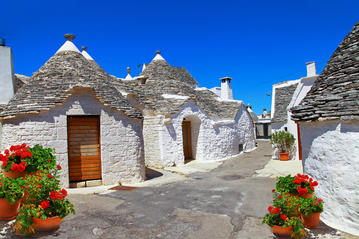Alberobello
TIME : 2016/2/22 11:38:35

Alberobello
A tiny commune in the Bari region, Alberobello has a couple of picture-perfect Baroque churches and a few small museums, but it is chiefly known for its UNESCO-listed trulli houses – miniscule lime-washed dwellings shaped like cupcakes topped by conical gray slate roofs that are unique to this area of Puglia. These houses are constructed of dry-stone walls without the use of mortar; they were designed to be dismantled easily to avoid paying the taxes imposed on permanent dwellings. Records show that scores of trulli existed in the area as far back as 1000 AD, although the oldest surviving ones in Alberobello date from the 14th century. More than 1,500 still remain in two steep, hilly areas on the town’s western flanks, and most are still inhabited today. The district of Aia Piccola is almost purely residential and is pleasant to wander for its serried ranks of small terraced trulli, some neatly ornamented with potted plants and bright flowers, others with hearts, evil eyes and religious symbols emblazoned on the simple slate roofs.
Rione Monti is the area to head for bars, cafés, boutique hotels and souvenir stores all packed inside miniature trulli dwellings; some have small terraces grafted on to their rear, giving amazing views over the gnome-like, white-tipped beehive-shaped houses as they sprawl downhill. There is even a trullo church dedicated to St Anthony, and Alberobello’s tourist office is also based in one of these hobbit-sized dwellings.
Practical Info
Alberobello’s trulli dwellings can be visited daily; many have been incorporated into stores, bars and hotels. The tourist office is at Monte Nero 1 and is open daily from 9 a.m. to 7:30 p.m.
